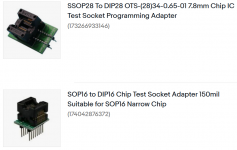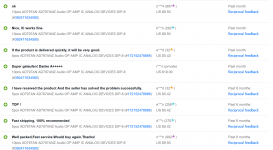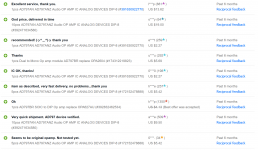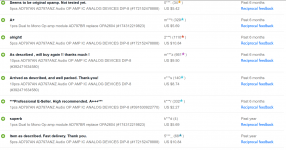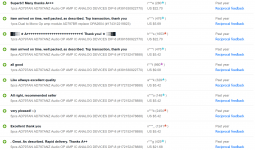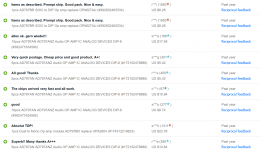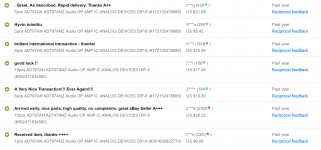Makes me wonder I bought (Have not gottem them yet) OPA1611.OPA1612 and OPA1656
and I recognosize the blue backgroung in the back of the opams,could they be fakes???
and I recognosize the blue backgroung in the back of the opams,could they be fakes???
I am afraid it seems quite possible. If they are coming from the same people who sold me LM741 marked as AD797 be careful. So far I have tested and found the following fakes: AD797, NE5532, TL071, TL072, TL074. [What I actually received was LM741, LM358, LM324.]
I test input offset voltage, input bias current (to verify that is it a FET or bipolar input), quiescent current, noise and distortion. I measure the noise using a 60 dB LNA in front of my sound card. I measure the distortion by putting them in the output filter position of one of my DACs (such as CS4398) and then measure with an E-MU 1616m or 1820m with a Hall notch filter. I measure one known genuine sample from an authorized distributor (Mouser or Digikey) for all the tests including noise and distortion before testing the unknown/suspect samples. I also use diode and resistance checks of any offset, compensation, no-connect and distortion cancellation pins (such as pin 8 of AD797).
I have also done scope tests with a square wave input and looking at the output of the unknown sample compared to a known genuine sample. Each op-amp has a signature (based upon slew rate, input voltage ranges and output voltage ranges, type of input stage, type of output stage, etc). This test can be done with 2k Ohm load and then 600 Ohm load since some op-amps can not drive 600 Ohm loads.
What was the price each and which seller?
How do you plan to evaluate them when they arrive to make sure they are not fake? This seems to be necessary for transistors, capacitors and op-amps bought online. I basically have a rule against buying this stuff online but I made an exception for the AD797 based upon the feedback and number sold. That was a mistake.
I test input offset voltage, input bias current (to verify that is it a FET or bipolar input), quiescent current, noise and distortion. I measure the noise using a 60 dB LNA in front of my sound card. I measure the distortion by putting them in the output filter position of one of my DACs (such as CS4398) and then measure with an E-MU 1616m or 1820m with a Hall notch filter. I measure one known genuine sample from an authorized distributor (Mouser or Digikey) for all the tests including noise and distortion before testing the unknown/suspect samples. I also use diode and resistance checks of any offset, compensation, no-connect and distortion cancellation pins (such as pin 8 of AD797).
I have also done scope tests with a square wave input and looking at the output of the unknown sample compared to a known genuine sample. Each op-amp has a signature (based upon slew rate, input voltage ranges and output voltage ranges, type of input stage, type of output stage, etc). This test can be done with 2k Ohm load and then 600 Ohm load since some op-amps can not drive 600 Ohm loads.
What was the price each and which seller?
How do you plan to evaluate them when they arrive to make sure they are not fake? This seems to be necessary for transistors, capacitors and op-amps bought online. I basically have a rule against buying this stuff online but I made an exception for the AD797 based upon the feedback and number sold. That was a mistake.
Last edited:
I also use SOP8 sockets with round pin headers to test SOP/SOIC8 (such as OPA1612) in my DAC. They need to have round pin headers to fit in the DIP machine screw sockets on the DAC.
Then SOP16 sockets mounted on round pin headers to test SOP/SOIC14 quad op-amps.
(See attached picture.)
Then SOP16 sockets mounted on round pin headers to test SOP/SOIC14 quad op-amps.
(See attached picture.)
Attachments
OPA1656 isadeleparts2010
OPA1611 and OPA1612 is adeleparts2010
The only way I can test them is listening. I don´t have other skills.
OPA1611 and OPA1612 is adeleparts2010
The only way I can test them is listening. I don´t have other skills.
Are you going to use them in a DAC (output I/V and/or filter?) or in a preamp?
If so there are pretty easy tests that can be done. Like a loopback from DAC to soundcard as a start. If you have a genuine NE5532 in the DAC you can then compare to OPA1656 and OPA1612.
If used in a preamp you can go Soundcard (DAC) > Preamp > Soundcard (ADC) and compare the distortion using REW (free software).
You can use REW to output 1kHz sinewave and then display a histogram of distortion. Then you can repeat at 10kHz.
The OPA1656 and OPA1612 should show clearly improved distortion performance at 10 kHz. If you get a remarked NE5532 you will not see an improvement. If you get a remarked LM358 the distortion will fall off a cliff.
If you have a digital voltmeter, breadboard and power supply you can do simple tests. Such as 1 Ohm or 10 Ohm resistor to sense quiescent current. You can wire as a voltage follower with first 2k Ohm to ground from the non-inverting input and then you measure input offset voltage. Then replace the 2k with 2M to test FET type op-amps for input bias current.
Lots of good information in this thread about REW: Howto - Distortion Measurements with REW
This is great software for DIY audio work: REW - Room EQ Wizard Room Acoustics Software
Analog Devices has this article about simple op amp measurements: Simple Op Amp Measurements | Analog Devices
If so there are pretty easy tests that can be done. Like a loopback from DAC to soundcard as a start. If you have a genuine NE5532 in the DAC you can then compare to OPA1656 and OPA1612.
If used in a preamp you can go Soundcard (DAC) > Preamp > Soundcard (ADC) and compare the distortion using REW (free software).
You can use REW to output 1kHz sinewave and then display a histogram of distortion. Then you can repeat at 10kHz.
The OPA1656 and OPA1612 should show clearly improved distortion performance at 10 kHz. If you get a remarked NE5532 you will not see an improvement. If you get a remarked LM358 the distortion will fall off a cliff.
If you have a digital voltmeter, breadboard and power supply you can do simple tests. Such as 1 Ohm or 10 Ohm resistor to sense quiescent current. You can wire as a voltage follower with first 2k Ohm to ground from the non-inverting input and then you measure input offset voltage. Then replace the 2k with 2M to test FET type op-amps for input bias current.
Lots of good information in this thread about REW: Howto - Distortion Measurements with REW
This is great software for DIY audio work: REW - Room EQ Wizard Room Acoustics Software
Analog Devices has this article about simple op amp measurements: Simple Op Amp Measurements | Analog Devices
Last edited:
I thought AD797 were in a sort of ceramic package?
Now I see there are "regular" plastic package ones as well
Now I see there are "regular" plastic package ones as well
It is pretty simple. Wire for a loopback, select "generator" in REW and setup sinewave at 1kHz with the correct level.
Then open the RTA window in REW. Try Hann window and to setup use 64k FFT setting.
First setup and try different levels while you "display distortion" in the RTA window. Find a good signal level (maybe -3 dBFS, maybe -10 dBFS) and see how the distortion varies with level.
When you have the levels setup and everything making sense switch to perhaps 512k FFT and 8 averages for actual measurements. I suggest measuring a known genuine reference op-amp in your DAC or pre-amp (which ever you are evaluating) and then repeating the exact measurement with the unknown/new op-amp.
I suggest comparing the RTA distortion spectra at 1kHz and 10kHz. 10kHz is tougher. You can see bigger differences at 10kHz.
Try to use ASIO drivers for Windows so you get 24 bit instead of the 16 bit resolution with the Java drivers under Windows. If you are Linux then I think you are 24 bits automatically.
Also download the REW 5.20 RC7 beta for best version right now.
Then open the RTA window in REW. Try Hann window and to setup use 64k FFT setting.
First setup and try different levels while you "display distortion" in the RTA window. Find a good signal level (maybe -3 dBFS, maybe -10 dBFS) and see how the distortion varies with level.
When you have the levels setup and everything making sense switch to perhaps 512k FFT and 8 averages for actual measurements. I suggest measuring a known genuine reference op-amp in your DAC or pre-amp (which ever you are evaluating) and then repeating the exact measurement with the unknown/new op-amp.
I suggest comparing the RTA distortion spectra at 1kHz and 10kHz. 10kHz is tougher. You can see bigger differences at 10kHz.
Try to use ASIO drivers for Windows so you get 24 bit instead of the 16 bit resolution with the Java drivers under Windows. If you are Linux then I think you are 24 bits automatically.
Also download the REW 5.20 RC7 beta for best version right now.
Last edited:
LM741 as a donor is unlikely, the 741 went out of fashion before faking became common. The dual 4558 is far more popular.
TL081 for a single is more likely
TL081 for a single is more likely
Since it was supposed to be a bipolar input I skipped the input bias current test. (I have only run that test when trying to confirm a FET input. I suppose I should not skip it since maybe someone will ship a FET input type device labeled with a bipolar part number.) I can go back and try that when I get a moment.
The TL081 has 1.08k resistors from the offset null pins to the negative supply so perhaps TL081 will fit all the observed measurements when I check the bias current. Pin 8 is also no connect as observed.
The TL081 has 1.08k resistors from the offset null pins to the negative supply so perhaps TL081 will fit all the observed measurements when I check the bias current. Pin 8 is also no connect as observed.
YOU-MUST-BE-JOKINGI am afraid it seems quite possible. If they are coming from the same people who sold me LM741 marked as AD797 be careful. So far I have tested and found the following fakes: AD797, NE5532, TL071, TL072, TL074. [What I actually received was LM741, LM358, LM324.]
You were REPEATEDLY hit and kept buying?
You must be a masochist.🙄
I can not believe you do ALL THAT and then expect to get a $13.38 part for 95 cents (package of 10)I test input offset voltage, input bias current (to verify that is it a FET or bipolar input), quiescent current, noise and distortion. I measure the noise using a 60 dB LNA in front of my sound card. I measure the distortion by putting them in the output filter position of one of my DACs (such as CS4398) and then measure with an E-MU 1616m or 1820m with a Hall notch filter. I measure one known genuine sample from an authorized distributor (Mouser or Digikey) for all the tests including noise and distortion before testing the unknown/suspect samples. I also use diode and resistance checks of any offset, compensation, no-connect and distortion cancellation pins (such as pin 8 of AD797).
Are you trolling us?
Again: are you a masochist?
WHY would you do that, repeatedly?
How many ICs do you need? 10? ... 20?
I understand saving cents on a part if 1000 needed, cents add up; BUT what´s the point of "saving", buying GUARANTEED FAKE parts, for pocket change amounts?
I REALLY don´t get you.
And then complain here .... what for?
You are not hurting them in the least, as you (and many others) have proven.
Shaking my head in disbelief.
From your own words you have done this many times.I basically have a rule against buying this stuff online but I made an exception for the AD797 based upon the feedback and number sold. That was a mistake.
I can´t blame you, last Month I made the terrible mistake of hiring a Private Investigator to find whether Rita Love, my new girlfriend after I won $650000 at a Las Vegas casino (she was a waitress there) is REALLY in love with me

Guess what he found? 😎
PS: if anybody thinks this picture and my words imply woman abuse or something, this comes from an App designed for young hot Women trying to catch "sugar daddies", this is not "Internet stuff" but an article in New York Post.
Free app Gaper matches young hotties with older men and women
So WHO is actually abusing WHOM?
It seems to be a "state of mind " nowadays where young people are programmed to be "good consumers " and buy-buy-buy even getting themselves into debt .
I remember in the UK you had "spivs " with suitcases full of ties with naked women on them and cheap fake watches and "nylons" wearing "zoot suites " .
Or a "barker " at an open air stall selling household rubbish that lasted 5 minutes , now all the same stuff is done online where we are told - the internet is the future of the business world and even the personal world .
I remember in the UK you had "spivs " with suitcases full of ties with naked women on them and cheap fake watches and "nylons" wearing "zoot suites " .
Or a "barker " at an open air stall selling household rubbish that lasted 5 minutes , now all the same stuff is done online where we are told - the internet is the future of the business world and even the personal world .
Totally agree with JMFahey.
I will never understand why people want to be scammed when the original part is still available from authorized distributors. I mean I get it when parts are EOL, but not this. Such a waste of time and money.
I will never understand why people want to be scammed when the original part is still available from authorized distributors. I mean I get it when parts are EOL, but not this. Such a waste of time and money.
As I mentioned in the first post I have a rule against buying transistors, capacitors and op-amps online based upon prior experience.
This was simply an experiment based upon the enormous amount of positive feedback for the particular item (AD797 search in feedback) and thousands sold.
I wanted to know if it was really possible that thousands of "do it yourself" types had purchased this "AD797" with zero negative feedback on the transaction. Is that because they received real ones? Or because they can not tell the difference? Do people really just blindly leave 5-star feedback with no idea about what they are saying?
Take a look at the feedback (attached). Perhaps this indicates that the online market systems of ratings and feedback are hopelessly meaningless. Perhaps they are fake themselves?
And if you knew this you would not warn anyone else on DIYAUDIO? If you see thousands sold and know very well that they are likely bought by "do it yourself" audio types you would not be bothered to post a message to warn others? When you see the quantities of thousands having been sold? The purpose of the thread was not to complain. More to educate others. Are there any posts on DIYAUDIO about the sound of such and such after being upgraded with AD797, OPA1612, etc? Except those are fake AD797 & OPA1612? Just wondering.
This was simply an experiment based upon the enormous amount of positive feedback for the particular item (AD797 search in feedback) and thousands sold.
I wanted to know if it was really possible that thousands of "do it yourself" types had purchased this "AD797" with zero negative feedback on the transaction. Is that because they received real ones? Or because they can not tell the difference? Do people really just blindly leave 5-star feedback with no idea about what they are saying?
Take a look at the feedback (attached). Perhaps this indicates that the online market systems of ratings and feedback are hopelessly meaningless. Perhaps they are fake themselves?
And if you knew this you would not warn anyone else on DIYAUDIO? If you see thousands sold and know very well that they are likely bought by "do it yourself" audio types you would not be bothered to post a message to warn others? When you see the quantities of thousands having been sold? The purpose of the thread was not to complain. More to educate others. Are there any posts on DIYAUDIO about the sound of such and such after being upgraded with AD797, OPA1612, etc? Except those are fake AD797 & OPA1612? Just wondering.
Attachments
Last edited:
Sorry, but your warning is 1001th warning after a 1000 similar warnings I have perceived since my childhood: Those who buy cheap, buy twice. Go on, nothing to see here
I did not know that the usually highly intelligent posters here were "susceptible " to online scams ?
That is something particular to the members of the public in the UK who are scammed every day in the UK and post in my previous UK "help " website and because its been happening for many years I have spent a lot of online time checking it out --in detail.
I used to get a lot of scam emails & telephone calls but since I don't "click the links " and can check out where they come from then reply ( although some say --quote you cant reply to this email - bull !) but they are so amateurish or they are not well up on English grammar they are easy to spot .
Even the scam calls have stopped as I leave my answering machine on 24/7 -- a lot of people in the UK are now enjoying themselves keeping the scammers on the phone for a long time slowly winding them up and due to Covid its actually helping their mental balance talking to some idiot who thinks they are speaking to an idiot.
When they realize they are the ones being made a fool after half an hour you should hear the language and that includes females.
Like JM I buy from mouser and the other big USA electronic component sellers --never had a problem with them.
That is something particular to the members of the public in the UK who are scammed every day in the UK and post in my previous UK "help " website and because its been happening for many years I have spent a lot of online time checking it out --in detail.
I used to get a lot of scam emails & telephone calls but since I don't "click the links " and can check out where they come from then reply ( although some say --quote you cant reply to this email - bull !) but they are so amateurish or they are not well up on English grammar they are easy to spot .
Even the scam calls have stopped as I leave my answering machine on 24/7 -- a lot of people in the UK are now enjoying themselves keeping the scammers on the phone for a long time slowly winding them up and due to Covid its actually helping their mental balance talking to some idiot who thinks they are speaking to an idiot.
When they realize they are the ones being made a fool after half an hour you should hear the language and that includes females.
Like JM I buy from mouser and the other big USA electronic component sellers --never had a problem with them.
I'm still surprised they bother to put actual chips in these. It's probably cheaper than empty packages.
Because 9 times out of 10 with opamps the board will sort of work and far too many buyers will accept them
Yes. But I did not expect such a high percentage of the buyers to be fooled.Because 9 times out of 10 with opamps the board will sort of work and far too many buyers will accept them
For a DAC at least do a loopback distortion test with REW at 6kHz using a known good sample and then the unknown. Or at the very least get one known genuine ok performance cheap op amp like a NE5532, NE5534 or 2068. The distortion will clearly drop if you then switch to a real high performance op amp.
If your DAC has a socket it takes minutes with REW. Plug in the cable for loopback, setup levels, set generator to 6kHz sine and then open the RTA window. Hann filter, 8 averages, 512k FFT. Then see what the op amp actually does.
- Home
- Design & Build
- Parts
- *Thousands Sold*, Great Reviews... Received Fake AD797 Like LM741. Did You Buy These?
